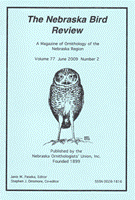Nebraska Ornithologists' Union

Nebraska Bird Review
Date of this Version
6-1984
Document Type
Article
Citation
“The Eighty-third Annual Meeting,” from Nebraska Bird Review (June 1984) 52(2).
Abstract
Almost perfect weather greeted the 59 who registered for the eighty-third Annual Meeting, held at Camp Norwesca, near Chadron State Park, 19 and 20 May 1984. There was a slide show (including a bird identification quiz) Friday night. Saturday there were bird trips to Sowbelly Canyon and Gilbert-Baker Wildlife Area, north of Crawford, and on over to the Wyoming border; to Soldiers Creek, near Fort Robinson; to Beaver Valley, north of Hay Springs; and a shorter, morning only, visit to the Jeanne Dueker home, south of Chadron. At the paper session and Annual Meeting, Saturday afternoon, Mrs. Joyce Brashear read a memorial to Doris Gates, written by Dr. Rosalind Morris, who was not able to be present. Lon Neth, Biology Department, Chadron State College, gave a paper “Winter Prey Remains in Great Horned Owl Pellets in Dawes Co., Nebraska”; Sue Fairbanks, Department of Fisheries and Wildlife Biology, Colorado State University, spoke on “Habitat Use and Foraging Behavior of Semicaptive Bighorn Sheep at Fort Robinson State Park”; and Dr. Roger Sharpe, Biology Department, University of Nebraska at Omaha, spoke on “Bird Migration Problems from Unusual Patterns in Nebraska”; Wayne Mollhoff, Albion, discussed some of the problems involved in the bird atlas project. The following officers were elected for the 1983–84 term: Gary Lingle, Grand Island, president; Mrs. Ruth Green, Bellevue, vice-president; Mrs. Emma Johnson, Omaha, secretary; Mrs. Lona Shafer, Wood River, treasurer; Dr. Neva Pruess, Lincoln, librarian; and Dr. R. G. Cortelyou, Omaha, editor.
The count for the meeting, covering parts of Dawes, Sheridan, and Sioux counties, was 112, plus a call, heard once, suspected of being an Eastern Meadowlark, Empidonax species, and a hawk suspected of being an immature Ferruginous Hawk, although some disagreed with that identification. The Lesser Goldfinch is a first for the state.


Comments
Copyright 1984 Nebraska Ornithologists’ Union. Used by permission.